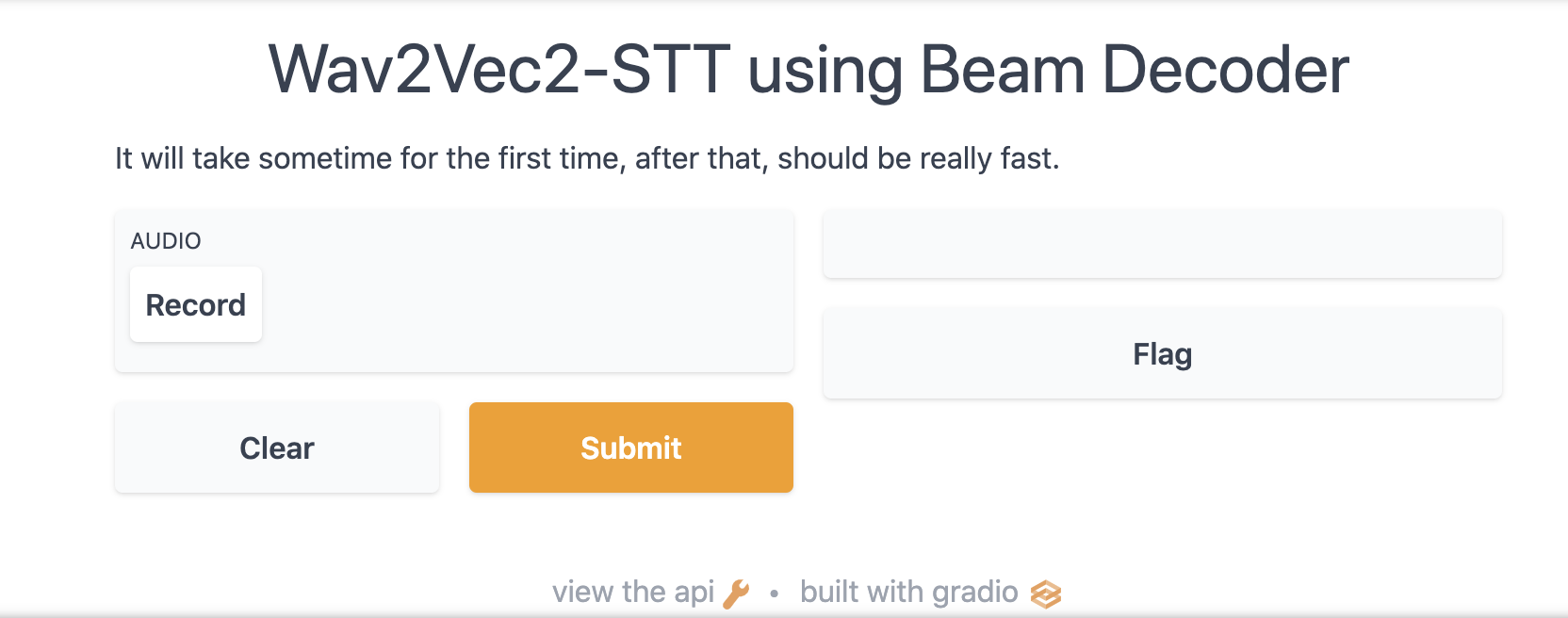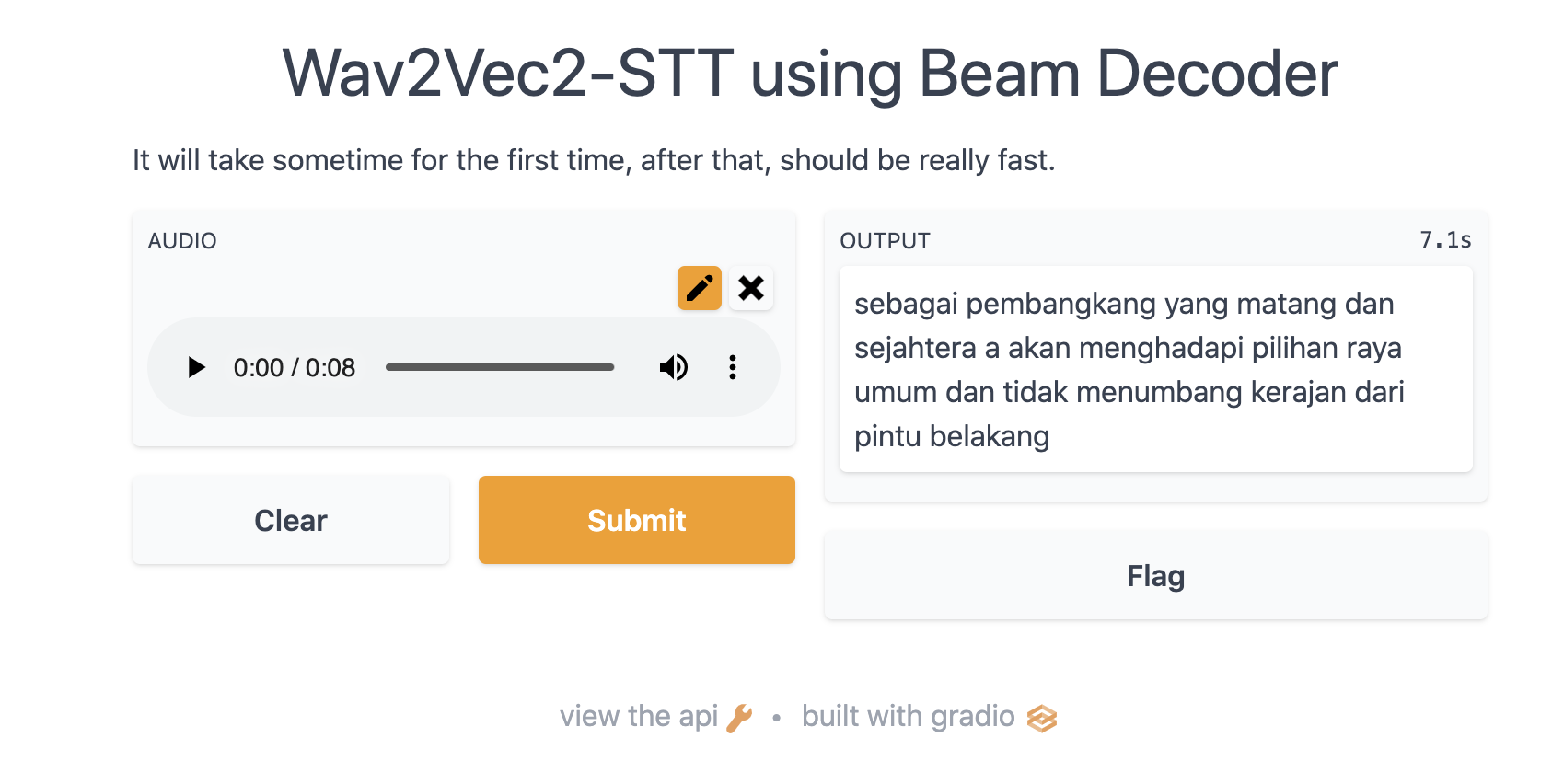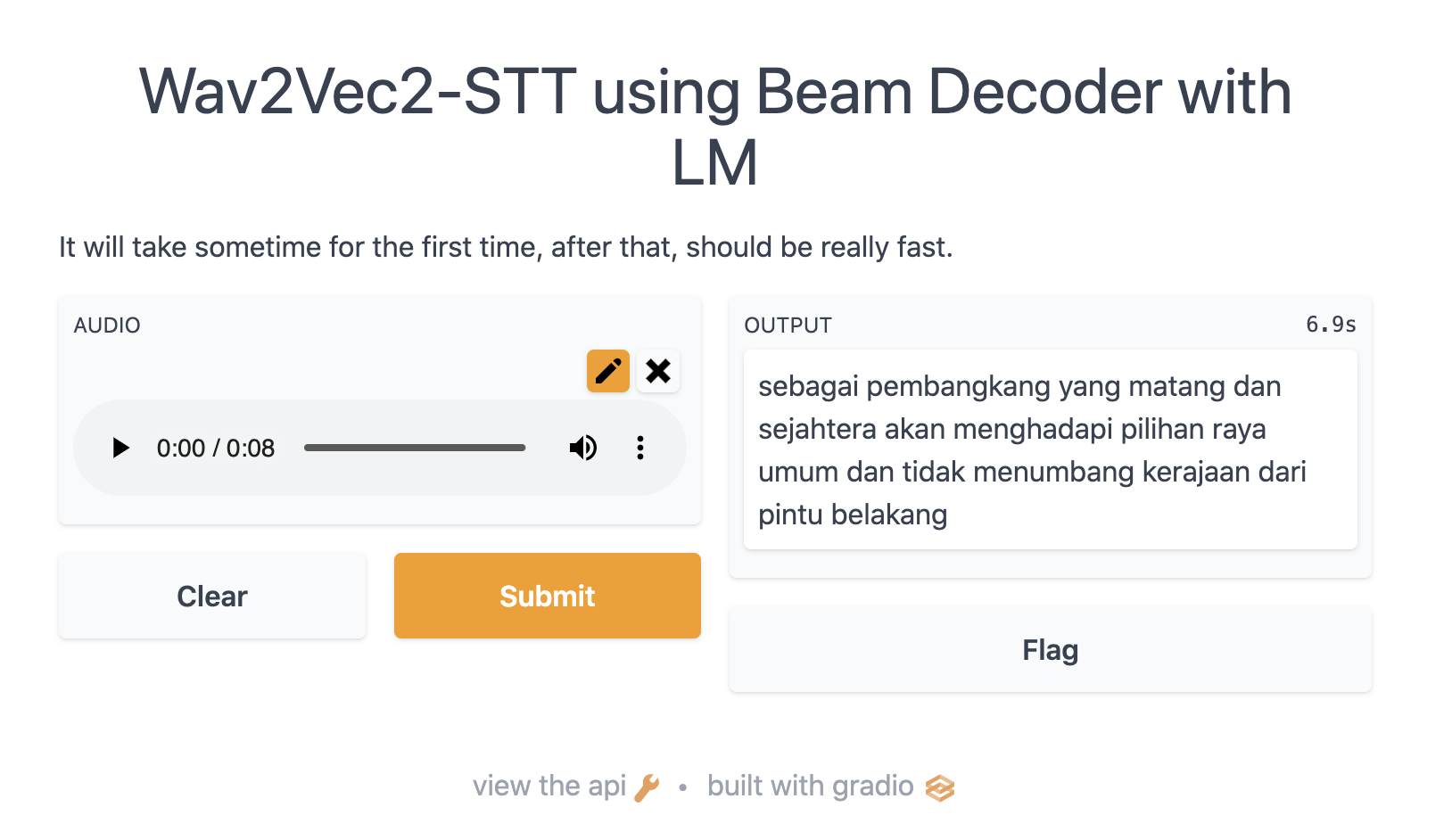Speech-to-Text CTC web inference using Gradio
Contents
Speech-to-Text CTC web inference using Gradio#
Encoder model + CTC loss web inference using Gradio
This tutorial is available as an IPython notebook at malaya-speech/example/stt-ctc-gradio.
This module is not language independent, so it not save to use on different languages. Pretrained models trained on hyperlocal languages.
[1]:
import malaya_speech
import numpy as np
from malaya_speech import Pipeline
List available CTC model#
[2]:
malaya_speech.stt.available_ctc()
[2]:
| Size (MB) | Quantized Size (MB) | WER | CER | WER-LM | CER-LM | Language | |
|---|---|---|---|---|---|---|---|
| hubert-conformer-tiny | 36.6 | 10.3 | 0.335968 | 0.0882573 | 0.199227 | 0.0635223 | [malay] |
| hubert-conformer | 115 | 31.1 | 0.238714 | 0.0608998 | 0.141479 | 0.0450751 | [malay] |
| hubert-conformer-large | 392 | 100 | 0.220314 | 0.054927 | 0.128006 | 0.0385329 | [malay] |
| hubert-conformer-large-3mixed | 392 | 100 | 0.241126 | 0.0787939 | 0.132761 | 0.057482 | [malay, singlish, mandarin] |
| best-rq-conformer-tiny | 36.6 | 10.3 | 0.319291 | 0.078988 | 0.179582 | 0.055521 | [malay] |
| best-rq-conformer | 115 | 31.1 | 0.253678 | 0.0658045 | 0.154206 | 0.0482278 | [malay] |
| best-rq-conformer-large | 392 | 100 | 0.234651 | 0.0601605 | 0.130082 | 0.044521 | [malay] |
Lower is better. Mixed models tested on different dataset.
Load CTC model#
def deep_ctc(
model: str = 'hubert-conformer', quantized: bool = False, **kwargs
):
"""
Load Encoder-CTC ASR model.
Parameters
----------
model : str, optional (default='hubert-conformer')
Model architecture supported. Allowed values:
* ``'hubert-conformer-tiny'`` - Finetuned HuBERT Conformer TINY.
* ``'hubert-conformer'`` - Finetuned HuBERT Conformer.
* ``'hubert-conformer-large'`` - Finetuned HuBERT Conformer LARGE.
* ``'hubert-conformer-large-3mixed'`` - Finetuned HuBERT Conformer LARGE for (Malay + Singlish + Mandarin) languages.
* ``'best-rq-conformer-tiny'`` - Finetuned BEST-RQ Conformer TINY.
* ``'best-rq-conformer'`` - Finetuned BEST-RQ Conformer.
* ``'best-rq-conformer-large'`` - Finetuned BEST-RQ Conformer LARGE.
quantized : bool, optional (default=False)
if True, will load 8-bit quantized model.
Quantized model not necessary faster, totally depends on the machine.
Returns
-------
result : malaya_speech.model.tf.Wav2Vec2_CTC class
"""
[3]:
model = malaya_speech.stt.deep_ctc(model = 'hubert-conformer')
web inference using Gradio#
def gradio(self, record_mode: bool = True,
lm_func: Callable = None,
**kwargs):
"""
Transcribe an input using beam decoder on Gradio interface.
Parameters
----------
record_mode: bool, optional (default=True)
if True, Gradio will use record mode, else, file upload mode.
lm_func: Callable, optional (default=None)
if not None, will pass a logits with shape [T, D].
**kwargs: keyword arguments for beam decoder and `iface.launch`.
"""
record mode#
[6]:
model.gradio(record_mode = True)
[9]:
from IPython.core.display import Image, display
display(Image('record-mode.png', width=800))

upload mode#
[8]:
model.gradio(record_mode = False)
[10]:
from IPython.core.display import Image, display
display(Image('upload-mode.png', width=800))

Use Language model#
[4]:
from functools import partial
from pyctcdecode import build_ctcdecoder
from malaya_speech.utils.char import CTC_VOCAB
import kenlm
[5]:
lm = malaya_speech.stt.language_model(model = 'dump-combined')
[6]:
kenlm_model = kenlm.Model(lm)
decoder = build_ctcdecoder(
CTC_VOCAB + ['_'],
kenlm_model,
alpha=0.2,
beta=1.0,
ctc_token_idx=len(CTC_VOCAB)
)
[7]:
def return_lm(logits):
out = decoder.decode_beams(logits, prune_history=True)
d_lm, lm_state, timesteps, logit_score, lm_score = out[0]
return d_lm
[9]:
model.gradio(record_mode = False, lm_func = return_lm)
[10]:
from IPython.core.display import Image, display
display(Image('upload-mode-lm.png', width=800))

[ ]:
